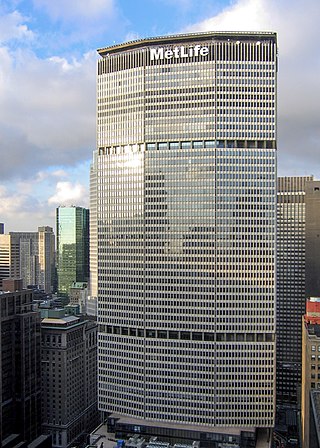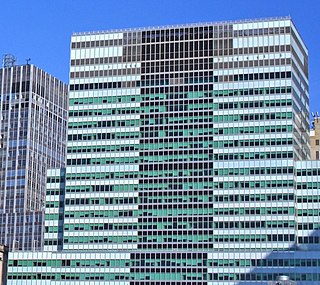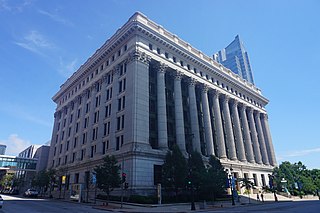Related Research Articles

MetLife, Inc. is the holding corporation for the Metropolitan Life Insurance Company (MLIC), better known as MetLife, and its affiliates. MetLife is among the largest global providers of insurance, annuities, and employee benefit programs, with around 90 million customers in over 60 countries. The firm was founded on March 24, 1868. MetLife ranked No. 43 in the 2018 Fortune 500 list of the largest United States corporations by total revenue.

The Manhattan Life Insurance Building was a 348 ft (106 m) tower on Broadway in the Financial District of Manhattan, New York City.

The Teachers Insurance and Annuity Association of America-College Retirement Equities Fund is an American financial services organization that is a private provider of financial retirement services in the academic, research, medical, cultural and governmental fields. TIAA is listed on the Fortune 100 and serves over 5 million active and retired employees participating at more than 15,000 institutions and has $1 trillion in combined assets under management with holdings in more than 50 countries.
The Equitable Life Assurance Society, founded in 1762, is a life insurance company in the United Kingdom. The world's oldest mutual insurer, it pioneered age-based premiums based on mortality rate, laying "the framework for scientific insurance practice and development" and "the basis of modern life assurance upon which all life assurance schemes were subsequently based". After closing to new business in 2000, parts of the business were sold off and the remainder of the company became a subsidiary of Utmost Life and Pensions in January 2020.

1 Wall Street is a mostly-residential skyscraper at the intersection of Broadway and Wall Street in the Financial District of Lower Manhattan in New York City, New York, U.S. Designed in the Art Deco style, the building is 654 feet (199 m) tall and consists of two sections. The original 50-story building was designed by Ralph Thomas Walker of the firm Voorhees, Gmelin and Walker and constructed between 1929 and 1931 for Irving Trust, an early-20th-century American bank. A 36-story annex to the south was designed by successor firm Voorhees, Walker Smith Smith & Haines and built between 1963 and 1965.
14 Wall Street, originally the Bankers Trust Company Building, is a skyscraper at the intersection of Wall Street and Nassau Street in the Financial District of Manhattan in New York City. The building is 540 feet (160 m) tall, with 32 usable floors. The original 540-foot tower is at the southeastern corner of the site, and a shorter annex wraps around the original tower.

New York Life Insurance Company (NYLIC) is the third-largest life insurance company and the largest mutual life insurance company in the United States, and is ranked #71 on the 2023 Fortune 500 list of the largest U.S. corporations by total revenue. In 2023, NYLIC achieved the best possible ratings by the four independent rating companies. Other New York Life affiliates provide an array of securities products and services, as well as institutional and retail mutual funds.
Great-West Lifeco Inc. is a Canadian insurance-centered financial holding company that operates in North America, Europe and Asia through five wholly owned, regionally focused subsidiaries. Many of the companies it has indirect control over are part of its largest subsidiary, The Canada Life Assurance Company; the others are managed by Great-West Lifeco U.S. LLC, a U.S. based subsidiary. Great-West Lifeco is indirectly controlled by Montreal billionaire Paul Desmarais Jr. through his stake in the Power Corporation of Canada, which owns 72% of Great-West Lifeco. The hyphen in the company's name was originally a typesetter's error.

The American Surety Building is an office building and early skyscraper at Pine Street and Broadway in the Financial District of Manhattan in New York City, across from Trinity Church. The building was designed in a Neo-Renaissance style by Bruce Price with a later expansion by Herman Lee Meader. It is 388 feet (118 m) tall, with either 23 or 26 stories. It was one of Manhattan's first buildings with steel framing and curtain wall construction.

Equitable Holdings, Inc. is an American financial services and insurance company that was founded in 1859 by Henry Baldwin Hyde. In 1991, French insurance firm AXA acquired majority control of The Equitable.

48 Wall Street, formerly the Bank of New York & Trust Company Building, is a 32-story, 512-foot-tall (156 m) skyscraper on the corner of Wall Street and William Street in the Financial District of Lower Manhattan in New York City. Built in 1927–1929 in the Neo-Georgian and Colonial Revival styles, it was designed by Benjamin Wistar Morris.

The Empire Building is an office building and early skyscraper at 71 Broadway, on the corner of Rector Street, in the Financial District of Manhattan in New York City. It was designed by Kimball & Thompson in the Classical Revival style and built by Marc Eidlitz & Son from 1897 to 1898. The building consists of 21 stories above a full basement story facing Trinity Place at the back of the building and is 293 feet (89 m) tall. The Empire Building is a New York City designated landmark and is listed on the National Register of Historic Places (NRHP). It is also a contributing property to the Wall Street Historic District, a NRHP district created in 2007.

The Gillender Building was an early skyscraper in the Financial District of Manhattan in New York City. It stood on the northwest corner of Wall Street and Nassau Street, on a narrow strip of land measuring 26 by 73 feet. At the time of its completion in 1897, the Gillender Building was, depending on ranking methods, the fourth- or eighth-tallest structure in New York City.

The Holdings of American International Group include the operating entities and subsidiaries of insurance conglomerate American International Group (AIG) that operates in over 130 countries. The company's business consists of four core areas: General Insurance, Life Insurance & Retirement Services, Financial Services and Asset Management.

108 Leonard is a residential structure in the Tribeca neighborhood of Manhattan in New York City, New York, United States. Built from 1894 to 1898, the building was constructed for the New York Life Insurance Company. Stephen Decatur Hatch created the original plans while McKim, Mead & White oversaw the building's completion. The building occupies a city block bounded by Broadway to the west, Leonard Street to the north, Lafayette Street to the east, and Catherine Lane to the south. It is a New York City designated landmark and is listed on the National Register of Historic Places.

2 Broadway is an office building at the south end of Broadway, near Bowling Green Park, in the Financial District of Manhattan in New York City. The 32-story building, designed by Emery Roth & Sons and constructed from 1958 to 1959, contains offices for the Metropolitan Transportation Authority (MTA). 2 Broadway serves as the headquarters for some of the MTA's subsidiary agencies.

Northwestern Mutual is an American financial services mutual organization based in Milwaukee, Wisconsin. The financial security company provides consultation on wealth and asset income protection, education planning, retirement planning, investment advisory services, Financial Planning trust and private client services, estate planning and business planning. Its products include life insurance, permanent life insurance, disability income, and long-term care insurance; annuities; investments; and investment advisory products and services. Northwestern Mutual ranked No. 90 on the 2021 Fortune 500 list of the largest United States corporations by total revenue and is in the top 30 by assets held. The firm distributes a portion of its earnings to eligible policyholders as annual dividends.

Ullico Inc. is a privately held insurance and financial services holding company in the United States. Formerly known as Union Labor Life Insurance Company, it was founded in 1927 by the American Federation of Labor (AFL) and its then president, Samuel Gompers, to offer health and life insurance products specifically to working men and women. Matthew Woll, president of the International Photo-Engravers Union of North America, became the company's first president. Ullico is one of the largest insurance and investment services companies for trade union members in the United States.

The Mutual Reserve Building, also known as the Langdon Building and 305 Broadway, is an office building at Broadway and Duane Street in the Tribeca neighborhood of Manhattan in New York City. The 13-story building, constructed between 1892 and 1894, was designed by William H. Hume and built by Richard Deeves, with Frederick H. Kindl as chief structural engineer. It is just east of the Civic Center of Manhattan, and carries the addresses 305–309 Broadway and 91–99 Duane Street.

The Home Life Building, also known as 253 Broadway, is an office building in Lower Manhattan, New York City. It is in Manhattan's Tribeca and Civic Center neighborhoods at the northwest corner of Broadway and Murray Street, adjacent to City Hall Park.
References
- ↑ "Life Insurance Annuity and Supplemental Health Insurance". May 17, 2016.
- ↑ State Of New York Insurance Department Report on Examination of The Manhattan Life Insurance Company (PDF) (Report). June 28, 2011. pp. Page 5, Section 3A. Retrieved January 14, 2015.
- ↑ "ManhattanLife | Life Insurance, Annuity, and Supplemental Health Insurance". May 4, 2020.
- 1 2 "The Manhattan Life Insurance". The Evening Post . New York, New York. 1850-08-16. Retrieved 2018-04-30– via Newspapers.com
 .
. - ↑ "The Oval Clinton Hat". Evening Post . 1824-05-04. Retrieved 2018-04-30– via Newspapers.com
 .
. - ↑ "Whig State Nominations". New-York Tribune . 1842-11-08. Retrieved 2018-04-30– via Newspapers.com
 .
. - ↑ "Williamsburgh Fire Insurance Company". The Brooklyn Eagle . 1847-07-21. Retrieved 2018-04-30– via Newspapers.com
 .
. - ↑ The History of Life Insurance in the United States to 1870: With an Introduction to Its Development Abroad, University of Pennsylvania, 1920, pp. 114–115
- 1 2 DiStefano, Joseph N. (May 14, 2002). "Loose Change: Builders, insurers worry about mold". The Philadelphia Inquirer. pp. E01.
- ↑ Slavery Era Insurance Registry Report May 2002, California Department of Insurance, retrieved January 26, 2015
- ↑ "Manhattan National Corp". Wall Street Journal. September 6, 1984. pp. Section 1, Page 31, Column 2.
- ↑ "Manhattan National Liquidation". Wall Street Journal. November 15, 1991. pp. Section A, Page 2, Column 2.
- ↑ "REPORT ON EXAMINATION OF THE MANHATTAN LIFE INSURANCE COMPANY" (PDF). State of New York. June 28, 2011. Retrieved 12 May 2015.
- ↑ "REPORT ON EXAMINATION OF THE MANHATTAN LIFE INSURANCE COMPANY" (PDF). State of New York. May 2, 2014. pp. 19, 21. Retrieved August 27, 2015.
- ↑ "ManhattanLife to acquire Standard Life and Casualty Insurance Company". Reinsurance News. 29 June 2020. Retrieved 18 August 2020.
- ↑ "In and About the City; a Fourteen-Story Building. the Manhattan Life Insurance Company to Have New Quarters". The New York Times. 1892-02-26. ISSN 0362-4331. Archived from the original on 2018-05-02. Retrieved 2018-04-30. Alt URL
- ↑ Manhattan Life Insurance Building, Emporis, archived from the original on October 25, 2012, retrieved July 11, 2013
{{citation}}: CS1 maint: unfit URL (link) - ↑ Manhattan Life Insurance Building , retrieved July 11, 2013
- ↑ The Underwriter, Life and Casualty: Historical and Biographical, Fidelity Publishing Company, 1896, p. 92.
- ↑ "Manhattan Life Insurance Co". The Wall Street Journal. 1893-01-19. Retrieved 2018-04-30– via Newspapers.com.
- ↑ "Wrecked the Restaurant; Violent Efforts to Oust a New Street Tenant. Mr. Gossford Wants $1,000 for Moving -- First Came a Shower of Bricks and Mortar, Then a Midnight Raid -- Now the Courts Take a Hand". The New York Times. 1893-02-15. ISSN 0362-4331. Archived from the original on 2018-05-02. Retrieved 2018-04-30– via Newspapers.com
 . Alt URL
. Alt URL - ↑ "66 BROADWAY SOLD; LONG A LANDMARK; Central Union Trust Reported Buyer of Manhattan Life Insurance Building. IT HOLDS ADJACENT SITE Land and 18-Story Building, Put Up in 1894, Is Assessed at $4,000,000 by the City.", New York Times, retrieved July 11, 2013
- ↑ "News of Bankers and Banks". Brooklyn Eagle. 1928-05-02. Retrieved 2018-04-30– via Newspapers.com
 .
.